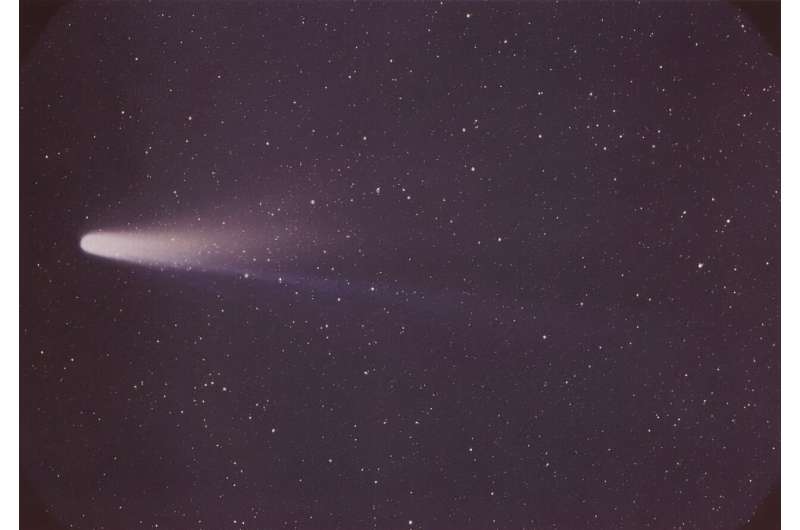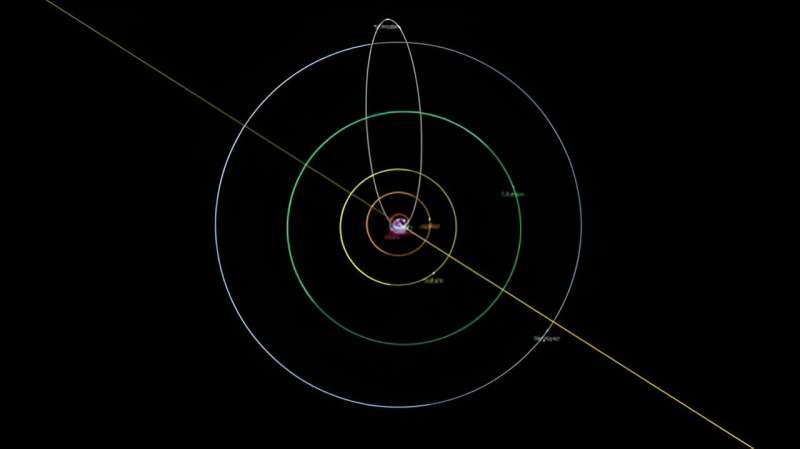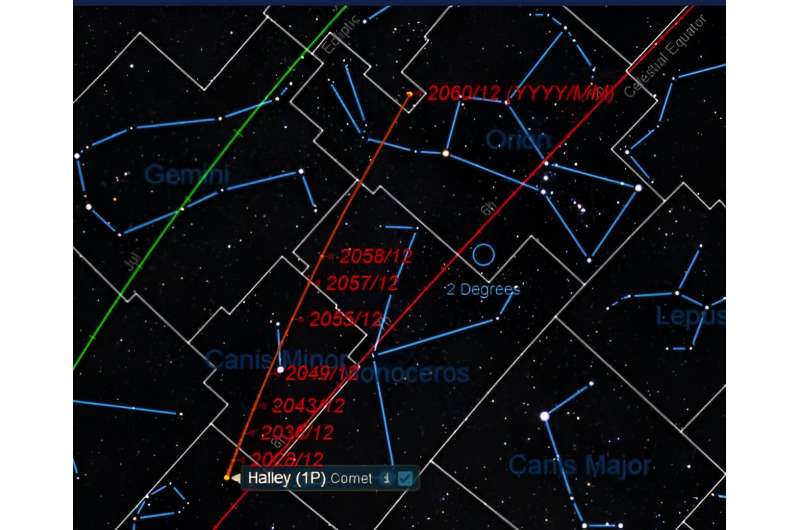This article has been reviewed according to Science X's editorial process and policies. Editors have highlighted the following attributes while ensuring the content's credibility:
fact-checked
trusted source
proofread
Famed Halley's comet passes aphelion this weekend

It's lonely out there in the frozen outer solar system. On Saturday, December 9th, that most famous of all comets 1P/Halley reaches a hallmark point on its 75-year journey through the solar system, reaching aphelion or its most distant point from the sun.
You could say that December 2023 represents a midpoint between the last 1986 and the next 2061 apparition for the comet. No one has seen Halley's Comet since the European Southern Observatory's Very Large Telescope imaged it a generation ago in 2003. At the time, it was 28 Astronomical Units (AU) distant at magnitude +28.
The exact moment of aphelion occurs at 1:00 Universal Time (UT) on December 9th, (8:00 PM EST on Friday night on the 8th). At that point, Halley's Comet will be 35.14 AU (almost 3.3 billion miles or 5.3 billion kilometers) from the sun. This puts the comet out beyond the orbit of Neptune, shining at +35th magnitude in the southern constellation of Hydra the Sea Serpent. The comet will also be moving at its slowest velocity, at 0.91 kilometers per second or 2,000 miles per hour respective to the sun.
This puts the comet well out of the range of amateur or even large professional telescopes. As of writing this, NASA has no stated plans to image Halley's at aphelion using Hubble or the JWST. Certainly, there would be little scientific advantage at doing this, other than pushing the space telescopes to their limits.
"I took a quick look through approved HST and JWST programs and I do not see any programs planning to observe Halley's Comet, either through imaging or spectroscopy." Christine Pullam (NASA-Space Telescope Science Institute) told Universe Today.

A short history of Halley's Comet
Halley's Comet has certainly made its mark on history. Sir Edmond Halley first noted the periodicity of the comet in 1696, linking one apparition to the next. Halley successfully predicted the return of the comet that now bears his name in 1758, though he did not live to see it.
The "1P" in its name denotes the fact that Halley's was the first periodic comet discovered. Periodic comets have an orbit shorter than 200 years. To date, 472 periodic comets are known. As sky surveys push deeper down the magnitude scale we're discovering ever fainter periodic comets, and we've most likely found all of the "great" ones.
Chinese observations of Halley's Comet date all the way back to 467 BC. The 1066 apparition of the comet was widely seen worldwide. Its appearance was taken as an omen preceding the death of King Harold the II at the Battle of Hastings and the ascension of William the Conqueror to the throne.
One (possibly apocryphal) tale states that Pope Callixtus the III "excommunicated" the comet as an admonition against the Ottoman Empire encroaching upon eastern Europe.
American author Mark Twain is also famously associated with Halley's Comet. Twain was born in 1835 during the comet's appearance, and predicted he would pass on with the comet's next appearance in 1910. (Spoiler alert: he did).
Modern appearances
Speaking of which, the anticipation for Halley's that year was actually upstaged by one of the greatest comets of the 20th century: The Great Comet of 1910. In fact, may people that remember Halley's Comet in 1910, actually saw the Great Comet just a few months prior. The discovery of poisonous cyanogen gas in the tail of the comet courtesy of the newfangled method of spectroscopy sparked the Great Comet Panic of 1910.

Unfortunately, the 1986 apparition of Halley's was a bit of a disappointment, as it appeared low to the south at dawn. Still, three space missions were dispatched to Halley's, for a first ever rendezvous with a comet. These were the Soviet Union's Vega 1 and 2, and the ESA's Giotto.
Two annual meteor showers are also associated with Halley: the April-May Eta Aquariids, and the October Orionids.
Sitting on the surface of Halley's Comet this weekend, the sun would shine at -19th magnitude. This is only about 250 times brighter than a full moon.
Halley's Comet in the years ahead
From our Earthly perspective, the comet spends the next few decades loitering in the constellation Hydra and into Canis Minor. The comet will pass very near the bright star Procyon in 2050. Halley's Comet next reaches perihelion on July 28th, 2061, and may break negative magnitudes in the months after. In September 2061, Halley's will appear low to the northwest at dusk for northern hemisphere observers.
It's now all inbound from here. Halley's Comet will get recovered once again in the coming decade, leading up to the 2061 apparition.
Provided by Universe Today





















